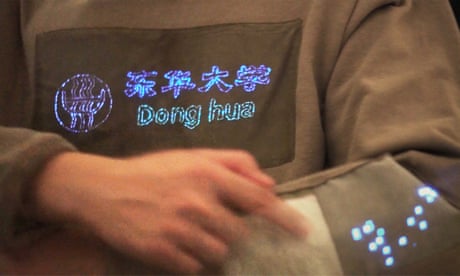
Whether it is a T-shirt that can display changing messages or a carpet that can sense where you are standing, the future of smart textiles has often seemed rooted in science fiction.
Now researchers say they have created smart fibres that can do exactly those things – and they do not even require a battery pack.
Researchers in China say they have created fibre-based electronics that harness electromagnetic energy in the atmosphere, using the human body as part of the circuit.
This makes a “body-coupled” fibre electronic technology that does not need electronic chips or batteries to work and which, the team say, could be used for a host of applications.
“When electromagnetic energy travels through the fibre, it is converted by fibres into other forms of energy, including visible light and radio waves. So, in addition to emitting light, the fibre emits electric signals when touched by [a] human body,” said Chengyi Hou, a co-author of the research from Donghua University, Shanghai.
By controlling various aspects of the system, such as the area of fibre in contact with the body or the diameter of the fibres, these wireless signals can be programmed, Hou added.
“These wireless signals can be conveniently picked up with a coil, and then wireless signals with different characteristics will be ‘translated’ by electronic devices into different commands,” he said, noting that could mean turning the device on or off, or other actions.
The team say the approach removes a key challenge faced when attempting to incorporate electronic systems into textiles: the need for rigid components.
“We have already achieved mass production of this new type of fibre electronics, which is as fine and soft as traditional fibres, so the next step is to apply it to textiles we use every day, such as cloths, towels, carpets and so on,” said Hou.
Among the prototypes developed by the team is a wearable fabric display coupled to a fabric keyboard – which the team say could be used by people who have a hearing impairment to help them communicate with others – and textile controllers for video games.
They also created a wireless haptic carpet that glows underfoot which not only provides a form of emergency lighting at night, but can also wirelessly transmit signals that can be used to control switches on appliances in the home, such as lights.
Writing in the journal Science, the team said that the fibres are composed of three layers, made from low-cost raw materials, and are durable, washable and sweat-resistant.
Writing in an accompanying article, Yunzhu Li, from the University of Illinois Urbana-Champaign, and Yiyue Luo, from MIT, suggest such technology could also have applications in robots and robotic prosthetics, as well as offer a way to gather tactile information to better understand interactions between humans and the objects around them.
Dr Luigi Occhipinti, director of research in smart electronics, biosystems and AI at the University of Cambridge, also said the approach has potential.
“As we are constantly in the proximity of sources of electromagnetic fields of various nature and with different characteristics, developing new classes of e-textiles that incorporate skin sensors and non-traditional electronics, powered uniquely via fibre-based energy harvesters in contact with our body, could unleash an entirely new class of self-powered wearable electronics for continuous monitoring of personal health,” he said.